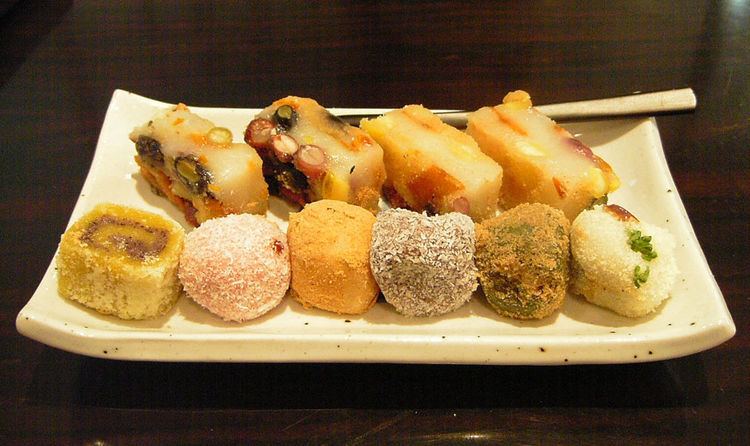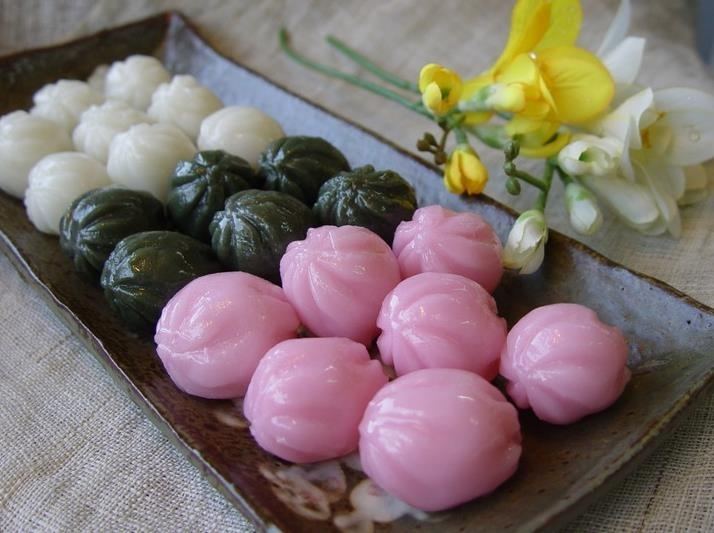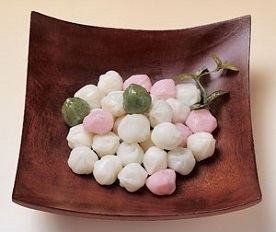Place of origin Korea | ||
 | ||
Variations Steamed, pounded, shaped, pan-fried Similar Tteok‑bokki, Mandu, Guk, Tteokguk, Gochu‑jang | ||
korean food spicy skewered rice cake tteok ggochi
Tteok (떡) is a class of Korean rice cakes made with steamed flour made of various grains, including glutinous or non-glutinous rice. Steamed flour can also be pounded, shaped, or pan-fried to make tteok. In some case, tteok is pounded from cooked grains.
Contents
- korean food spicy skewered rice cake tteok ggochi
- Utensils for making tteok
- Types
- Steamed tteok
- Pounded tteok
- Shaped tteok
- Pan fried tteok
- Other varieties
- Dishes made with tteok
- References
Tteok has been enjoyed not only as desserts or seasonal delicacies, but also as meal. It can range from elaborated versions made of various colors, fragrances, and shapes using nuts, fruits, flowers, and namuls, to plain white rice tteok used in home cooking. Some common ingredients for many kinds of tteok are red bean, soybean, mung bean, mugwort, pumpkin, chestnut, pine nut, jujube, dried fruits, sesame seeds and oil, and honey.

Tteok is usually a food that is shared. Tteok offered to spirits are called boktteok ("good fortune rice cake") and shared with neighbours and relatives. It is also one of the celebratory food that cannot be missed in banquets, rites, and various festive events. Tteokguk ("rice cake soup") was shared to celebrate new year and songpyeon was shared on harvest festival.

Utensils for making tteok
The below are cooking utensils to make tteok in the traditional Korean way.
Types
Tteok is largely divided into four categories, such as "steamed tteok" (찌는 떡), "pounded tteok" (치는 떡), "boiled tteok" (삶는 떡) and "pan-fried tteok" (지지는 떡). The steamed tteok is made by steaming rice or glutinous rice flour in "siru" (시루), or a large earthenware steamer, so it is often called "sirutteok" (시루떡). It is regarded as the basic and oldest form of tteok. The pounded tteok is made by using a pounding board or mortar after steamed first. In making pan-fried tteok, the rice dough is flattened like a pancake and pan-fried with vegetable oil. The shaped tteok are made by kneading a dough with hot water which is usually shaped into balls.
Steamed tteok
The main ingredients for steamed tteok or "sirutteok" are rice (맵쌀, maepssal in Korean) or glutinous rice (찹쌀 chapssal) and sometimes they are mixed together. In some cases, other grains, beans (azuki beans or mung beans), sesame seeds, wheat flour, or starch can be mixed with the rice. Various fruits and nuts are used as subsidiary ingredients, such as persimmons, peaches or apricots, chestnuts, walnuts, and pine nuts. In addition, vegetables with flavors or herbs can be used to flavor the tteok. Danggwi leaves (Ostericum grosseserratum), seogi mushroom (manna lichen), radish, artemisia, pepper, and cheongju are the most common flavorings, and honey and sugar are used as sweeteners.
In order to make steamed tteok or sirutteok, rice or glutinous rice is soaked in water for a while, then ground. The prepared rice flour is put in a siru and steamed. According to steaming method, sirutteok is subdivided into two groups; seolgitteok (설기떡) is shaped into a single large lump whereas kyeotteok (켜떡) consists of multiple layers with azuki bean powder or other bean powder. Seolgitteok is also called muritteok (무리떡), regarded as the most basic form of sirutteok made only with rice. On the hand, in making kyeotteok, rice and glutinous rice are mixed. The name of kyeotteok derives from the adverb kyeokeyo (켜켜, literally "filed") in Korean because the tteok is made as such.
Pounded tteok
In the traditional preparation, pounded tteok is made by pounding rice or glutinous rice with utensils called jeolgu and jeolgutgongi or tteokme and anban. Injeolmi (tteok coated with azuki / red bean powder or roasted soybean powder), garaetteok (가래떡 cylinder-shaped white tteok), jeolpyeon (절편 patterned tteok) and danja (단자 glutinous tteok ball coated with bean paste)” are commonly eaten pounded tteok.
Rice and glutinous rice are peeled off to make grain particles or powder, and steamed in a siru (earthenware steamer) and then pounded with the untensils. The pounded tteok is divided into glutinous pounded tteok (찹쌀도병 chapssal dobyeong) and non-glutinous pounded tteok (맵쌀도병 mapssal dobyeong) by rice type. Injeolmi that is a representative of the glutinous pounded tteok has varieties in accordance with gomul types (고물, coating made with bean powder, sesame seeds, or sliced jujubes) or subsidiary ingredients mixed into the steamed rice while pounding on the anban. Patinjeolmi (팥인절미), and kkaeinjeolmi (깨인절미) are the examples for the former, coated with red bean powder and sesame respectively. In ssuk injeolmi (쑥인절미) and surichwi injeolmi (수리취인절미) are ssuk (Artemisia princeps var. orientalis) and surichwi (Synurus deltoides (AIT.) NAKAI) added.
